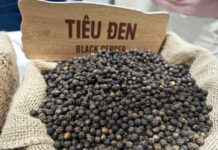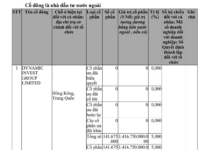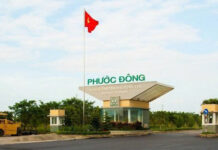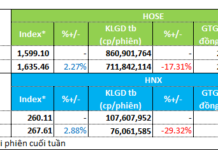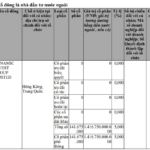The root crop in question is cassava, often referred to as ‘white gold’ due to its significant export value, bringing in billions of dollars for Vietnam.
According to the Import-Export Department (Ministry of Industry and Trade), the demand for importing cassava chips from Cambodia is expected to rise further in the 2025/2026 season. Recently, the Cambodian Cassava Federation and the Vietnam Cassava Association signed a Memorandum of Understanding (MoU) for comprehensive cooperation in production, processing, and trade. This agreement will see approximately 9 million tons of fresh cassava annually transported from Cambodia to Vietnam for processing and re-export.
Meanwhile, Vietnam’s exports of cassava and its derivatives continue to show impressive growth. In the first 10 months of 2025, Vietnam exported 3.34 million tons, valued at 1.03 billion USD, a nearly 60% increase in volume compared to the same period last year. Notably, cassava chips and starch exports to China, the largest market, reached 3.16 million tons, worth over 962 million USD.
Beyond China, South Korea is an emerging market of interest. In October 2025, exports to this market surged by 1,573% year-on-year, although the overall 10-month figure still showed a decline compared to the previous year, indicating fluctuating demand. This highlights the need for Vietnam to adopt a long-term strategy to maintain traditional markets while exploring new ones.

Cassava harvesting (illustrative image).
Promoting the Restructuring of the Cassava Industry
Vietnam currently ranks 5th globally in cassava yield, with a total cultivation area ranging from 520,000 to 550,000 hectares, producing over 10 million tons annually. The country boasts 140 processing plants, primarily in the Southeast region, with a combined actual capacity of over 9 million tons of fresh tubers per year.
However, the cassava production chain is not yet fully sustainable. The use of disease-resistant varieties remains low; cultivation techniques are not tailored to specific ecological zones; farmer-enterprise linkages are weak; mechanization is limited; and raw material areas are fragmented and vulnerable to climate change.
To address these challenges, the Ministry of Agriculture and Environment has approved the “Sustainable Development Plan for the Cassava Industry by 2030, Vision to 2050.” This plan aims to shift the industry from a broad-based growth model to green, high-efficiency production.
By 2030, the plan targets fresh cassava production to reach 11.5–12.5 million tons, with 85% of the output undergoing deep processing (starch, ethanol, monosodium glutamate, etc.). It also aims for 40–50% of the area to use certified varieties, 50% of the area to adopt sustainable farming practices, and export revenue to reach 1.8–2.0 billion USD.
By 2050, the plan envisions 70–80% of the cassava cultivation area to be sustainably managed, over 90% of the cassava to be used for deep processing, and export revenue to reach 2.3–2.5 billion USD.
Sustainable Farming and Circular Processing
To achieve these goals, experts emphasize several key solutions: stable raw material zoning, especially in hilly and nutrient-poor areas; expanded cultivation of disease-resistant and disease-free cassava varieties to control mosaic disease—the biggest threat currently; development of sustainable farming models that conserve fertilizers and prevent soil erosion; strengthened production linkages between farmers, cooperatives, enterprises, and processing plants; and the application of circular processing technologies to maximize the use of by-products (cassava pulp, peels) for animal feed, organic fertilizers, reducing emissions, and adding value.
Additionally, diversifying export markets to reduce dependence on China and targeting markets like South Korea, Japan, and Europe is crucial. While international markets offer numerous opportunities, Vietnam’s cassava industry must take decisive steps to enhance competitiveness. By promoting disease-resistant varieties, improving sustainable yields, expanding deep processing, and optimizing logistics, Vietnam can sustain growth amidst increasing competition and unpredictable market fluctuations.
Ministry of Home Affairs Addresses Rumors of Further Merging 16 Provinces and Cities
This morning, November 17th, Phan Trung Tuan, Director of the Department of Local Government at the Ministry of Home Affairs, confirmed that currently, the Party, National Assembly, and Government have no plans to continue implementing the reorganization or merger of provinces, cities, or commune-level administrative units.
Two Individuals Fined VND 3 Billion for Stock Manipulation Using 19 Accounts
The State Securities Commission (SSC) has recently issued penalties against multiple individuals involved in the manipulation of Petro Times Corporation’s (PPT) stock. Two individuals were fined a total of 3 billion VND for using 19 accounts to repeatedly buy and sell shares, artificially creating supply and demand to manipulate the stock price.
Thai Tycoon Reaps Windfall Dividends from Vietnamese Enterprises
After 13 years, Nawaplastic Industries Co., Ltd. has reaped over VND 2.824 trillion in dividends from Binh Minh Plastics, equivalent to their initial investment in shares. Meanwhile, Vietnam Beverage has garnered approximately VND 15.4 trillion in dividends from Sabeco, and F&N Dairy Investments has collected more than VND 15 trillion in dividends from Vinamilk.




